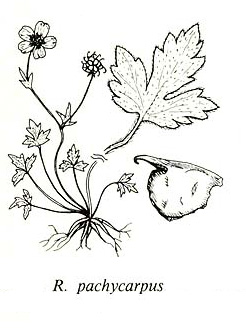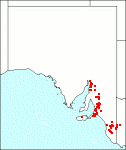Family: Ranunculaceae
Ranunculus pachycarpus
Citation:
B. Briggs, Proc. Linn. Soc. N.S.W. 84:301, fig. 2:11-16 (1960).
Synonymy: Ranunculus lappaceus Common name: Thick-fruited buttercup.
Description:
Perennial, 6-40 cm high with fleshy somewhat tuberous roots.
Flowering stems simple or branched, with 1-5 flowers, with long spreading hairs on lower part; leaves mostly basal, hirsute, with soft subappressed hairs 1-2 mm long; basal leaves with petioles 1-12 cm long, blades ovate to elliptic, 0.8-4.5 cm long, about as broad, coarsely dentate with 3-7 teeth, or ternately dissected, or lobed with lobed or dentate segments, lobes broad- to narrow-lanceolate, acute, when ternate the central petiolule to 1 cm long, twice as long as the lateral ones; flowers 1.5-2 cm diam.; sepals 5, spreading, ovate-concave, with long spreading hairs on the back; petals 5, obovate-cuneate, 6-15 mm long, 3-10 mm broad, obtuse, truncate or emarginate at the apex, the 3 primary nerves usually repeatedly forked in the lower half; nectary 0.2-1 mm above the base; nectary-lobe oblong or cuneate, truncate or emarginate, laterally attached to the petal for about half of its length; stamens 25-45; carpels 15-30; achenes in a globular to ellipsoidal head, 7-11 mm long, globular or obovoid-cuneate, 2.5-5 mm long, 2-3.5 mm dorsiventrally.
Pericarp very thick; lateral faces smooth, often with a shallow dorsal groove; beak 1.5-2 mm long, recurved or straight with a recurved tip; fruiting torus 5-8 mm long; staminal zone glabrous, achene zone hirsute with short fine hairs.

| Ranunculus pachycarpus
|
Image source: fig 197e in Jessop J.P. & Toelken H.R. (Ed.) 1986. Flora of South Australia (4th edn).
|
Published illustration:
Cunningham et al. (1982) Plants of western New South Wales, p. 310.
|
|
Distribution:
|
S.Aust.: FR, NL, MU, YP, SL, KI, SE. N.S.W.; Vic.
|
Conservation status:
native
Flowering time: July — Nov.
|

SA Distribution Map based
on current data relating to
specimens held in the
State Herbarium of South Australia
|
Biology:
No text
Author:
Not yet available
|

